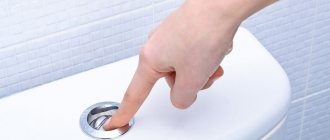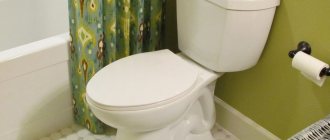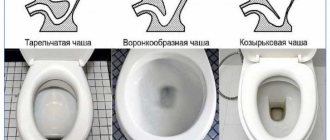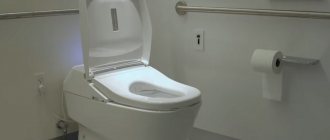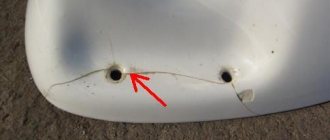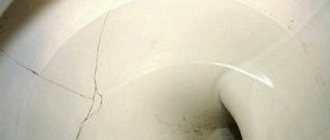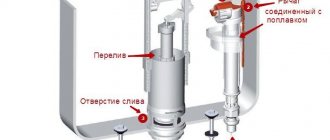There can be many reasons why a traffic jam has formed. Let's consider the main ones:
- Contamination in the flush system. Trouble can arise due to the accumulation of fat (if the sewage system from the kitchen passes through the main flush). Food and other unfiltered debris may end up here. The same toilet paper can be the cause if it does not decompose from water.
- There is not enough fluid in the drain tank. If the toilet has stopped flushing and you don’t know what to do, take a closer look at the amount of water in the tank. Perhaps its float is faulty and the water is not filling up to the desired level. The bowl will not clean due to lack of liquid if the reservoir is leaking.
- There is no water pressure when flushing. The drain channels are clogged and need to be cleaned.
- The surface of the bowl is worn out, which makes it rough, making it impossible to wash it off with copious amounts of water.
- Lack of fan riser. Residents of private houses face this problem. An air pocket forms, which prevents the passage of water.
These are the main reasons why the bathroom does not flush.
No fan boner
More than 80 percent of private houses do not have a vent riser. Hence the plugs in the circuit, as well as flushing with pops and difficulties. This is the main reason why toilets in private homes do not flush well. In essence, a fan riser is a ventilation system for the sewer system, which allows accumulated gases to be discharged into the atmosphere.
There is a way out of the situation. It consists of installing a vacuum valve at the highest point of the circuit, for example, on the roof. Problems with installing a drain pipe can be solved even after installing the main sewer circuit.
Improper installation of sewerage
The next reason is improper laying of sewer pipes, incorrect slope. The diameter of the sewer pipe is incorrectly selected. The diameter of the sewer pipe should be approximately 100 mm (10cm). It happens that construction debris, sand, or mortar gets into the pipe, as a result, the passage of the pipe is reduced and then the ingress of hair, cotton wool or wood litter for cat litter firmly clogs the toilet.
The quality and defects of the toilet itself, you purchased a non-certified product, for example, in China, with a small drain neck with a mousehole diameter of 50 mm.
Installation of sewer pipes is carried out at a slope within strictly defined limits.
If the slope is small, the liquid simply will not flow down them, and if the slope is too large, the water will drain quickly, but the contamination will remain in the pipe.
Paradoxically, excessive “leaking” of the sewer pipe leads to chronic blockages. SNiP give the following values for MINIMUM slopes of sewer pipes:
With diameter
- 50 mm – 30 mm/m.
- 110 mm – 20 mm/m.
- 160 mm – 8 mm/m.
- 200 mm – 7 mm/m.
The MAXIMUM slope should not exceed 150 mm/m, with the exception of bends for plumbing fixtures up to 1.5 m long. Connecting sewer pipes at right angles is allowed only in a vertical plane.
Supply tube clogged
Each tank has a tube that supplies water to it. It is made of corrugated material and is screwed on with two nuts. If you notice that liquid is not flowing into the tank, or is being collected slowly (sometimes for an hour), then turn off the system, remove the tube and knock out all the dirt from it.
Blockages in the supply pipe can form due to poor quality water, which is often encountered in city apartments. Blockages in the form of deposits on rust pipes can form in systems where the water supply circuit is built on metal pipes.
After removing the tube, it is worth checking the filter that is located at the entrance to the tank. There is a very fine mesh, which often becomes the culprit of blockage in the supply circuit. It should be rinsed with a generous stream, and the bathroom will be filled properly.
Efficiency of the drain system
The cause of a malfunction in a new toilet is not difficult to understand if you understand the features of plumbing and its design. The toilet is a bowl with a flushing container connected to it. The liquid is collected in a container. After pressing the trigger, the liquid rushes down.
A variety of materials are used to make a tank, but they are usually made of earthenware or cast iron. The choice of these materials is due to reliability. For some models, the tanks are made of plastic.
The bowl overflows when flushing
What should you do if the toilet bowl fills up completely? As a rule, the cause of this is a clogged toilet connection pipe or siphon. To solve the problem, you need to take a plunger and try to push the dirt out with compressed air. If the water is washed off well, then the problem is solved. Often you have to push through the blockage with a plumbing cable.
If there is contamination in the corrugation, the cable should not be too long. As a last resort, you can remove the corrugation or eccentric if the toilet still does not flush. The problem can be solved by using a chemically active medium that is poured over the clog. Since the weight of household chemicals is greater than water, it settles, dissolves and penetrates to the problem site, destroying it.
Plumbing cleaning
Over the years, old plumbing loses its original qualities and begins to function problematically. This is due to damage to the enamel. Chips and cracks appear on it. Over time, even the most expensive enamel becomes rough. As a result, waste does not quickly enter the sewer system. With each press of the button, the passage becomes more and more clogged and the water begins to drain worse.
The best way out of the situation would be to replace the toilet with a new model. But this cannot be called practical advice, since such problems need to be solved immediately.
The solution is to arm yourself with a plunger, chemicals, rags and plumbing rope. It is not a fact that all the proposed devices will necessarily be needed. Most often, high-quality cleaning requires the first two products.
There are two types of plunger - regular and pneumatic. Its activation creates pressure differences, and the water begins to independently push dirt through the pipe. True, it is not possible to effectively clear the passage every time.
Using a variety of chemicals, you can quickly dissolve accumulations of dirt on any part of the duct. You just pour the acid into the toilet and it starts to work. At the end, you can use a plunger or a special brush again.
The cable is used only in the most difficult cases. If no alkalis or other means help, it means that something is stuck in the pipe that can only be reached with a plumbing cable. It is pushed into the pipe, rotating. It is advisable not to damage the enamel of the toilet bowl.
Basic Problem Solving
Previously, we have already touched on the general principles of solving the problem. This is a hydrodynamic method, mechanical and chemical. Sometimes working with all three methods in combination helps, and sometimes you can get by with little pain by performing only one event.
All this is purely individual; always focus on the complexity of the problem when making the final decision on the spot.
Mechanical cleaning
It involves the use of a mechanical cable. This can be either a special tool or a regular long cable. They gradually insert it through the drain hole of the bathroom and begin to twist it clockwise, and then in the opposite direction. While rotating, the cable touches the edges of the blockage and touches deposits on the pipes, gradually eliminating the blockage or air lock.
When taking corrective measures, it is recommended to go around the neighbors above and ask them not to use the sewer. Instead of wire, they sometimes use a rag, inserting a rolled up towel into the system and pushing the blockage through with progressive movements.
The third option for mechanical impact is the use of a plunger. The tool, although simple, requires the right approach and adherence to the following sequence of actions:
- Fill the bowl with water until the drain hole is completely hidden. It is better to add fluid from a bucket, since the system does not drain, and using the tank may result in an overflow of the circuit.
- We create a seal around the entire circuit so that there is no escape for air. This cannot always be done, but if it works, it is recommended to close the overflows into the bathtub, washing machine, washbasin, and sink.
- We take the plunger and forcefully place it over the hole so that it completely falls under the elastic band. We begin to pump the circuit 5 to 10 times, after which we remove the plunger and check.
- Having heard the characteristic sounds in the system and the murmur of escaping water, we can conclude that the blockage has been overcome. If the water is washed off, but very slowly, then perform the manipulations up to 10 more times.
- Once the mash is finished, heat up the water and run it through the circuit to take preventive measures.
Obstructions in the drain hole
The first thing to check if the toilet doesn't flush well is the drain hole. You can understand that the problem is a clogged drain by a characteristic sign - a significant decrease in pressure. The water flows too slowly, the pressure is weak.
The tank has a small hole at the bottom. It is closed with a special valve. Over time, this hole becomes clogged and lime deposits accumulate on it. As a result, water cannot flow normally into the toilet.
The solution is to take phosphoric acid or 3 standard packages of citric acid. The selected substance is added to the tank and left for several hours. The ideal option is to leave this composition overnight. In the morning all that remains is to flush it down the toilet.
Often the cause of poor water pressure is a foreign object, which, surprisingly, can get into the tank at any time. These are pieces of hose, o-rings and other items. Therefore, when disassembling the structure, you need to pay attention to the bottom of the tank.
Causes of breakdowns and repair methods
Another cause of your toilet not flushing well could be the insufficient amount of water used for flushing. This drawback is also easily determined visually: the volume of water that drains from the tank is clearly small.
To eliminate this problem, you first need to determine the design features of the cistern. Any tank is a container inside of which there are mechanical devices that control the amount of water collected and determine how much liquid will be consumed with each flush.
Float, lever and valve
Very common models of flush tanks are devices with a float mechanism. In such tanks, the volume of water collected is regulated by a float mounted on a lever, which opens or closes the tank inlet valve. Malfunctions may occur in this mechanism that interfere with draining.
Damage to the float. This part is usually a hollow plastic vessel. During operation, various damage may occur in the float, leading to water getting inside it. As a result, the vessel is immersed in water more than is determined by the design features. This deficiency can be corrected by sealing the hole in the float and draining the water from it, or by completely replacing this unit.
The plastic float is usually mounted on a lever made of a metal rod. During operation, the rod may bend, which will also prevent the system from adequately opening and closing the inlet valve. Open the toilet tank lid and check that the float mechanism is functioning correctly.
Poor flushing can also be caused by poor operation of the inlet valve, which does not completely fill the drain tank. Check its condition. To do this, open the lid of the drain tank and move the lever leading from the valve to the float to its extreme positions. In the upper position, the valve should be completely closed, and in the extreme lower and even middle position of the lever, a maximum stream of water should flow from the valve into the tank.
During operation, the valve throughput can become clogged with various deposits and dissolved suspensions contained in tap water. Try turning off the water in the toilet supply hose, moving the float mechanism lever to the position corresponding to the maximum opening of the valve and cleaning the hole with a wooden toothpick.
The next component that can cause poor flushing performance may be the outlet valve. In a tank with a float mechanism, it may look like a lever on the side of the tank. Inadequate flushing performance may be caused by wear of the sealing parts of the valve device. To eliminate this problem, remove the toilet lid, turn off the water and, having gained access to the outlet valve, replace it.
A similar replacement of the outlet valve can be done in the cistern, the release of which is initiated by a lever on the toilet lid that is pulled upward.
Release valve with handle
A more complex device has a mechanism that regulates the intake and drainage of water in tanks equipped with a drain column. You can distinguish tanks with such a mechanism by the button, which is located on the top cover of the tank and initiates draining of water. If the drain column fails, it is usually replaced entirely.
Removing the drain column
The second option is to use soda
The second cleaning option is to use baking soda. Washing soda ash is better suited for punching the gap, but baking soda is also possible. Some experienced housewives recommend adding regular salt - about half the amount of soda.
Washing soda ash is suitable for cleaning toilets and sewer pipes.
- Take a pack of soda (500 grams) and pour it into the toilet.
- Then the toilet is filled with a liter of boiling water. After this, a reaction will begin inside the knee, which can also clear it of the blockage. Soda is an active alkali that can dissolve many substances, so it is often used not only for cleaning plumbing fixtures, but also kitchen accessories.
Causes of light stool
However, the presence of too dense and light stools that cannot be dispersed for a long time is not always a consequence of the disease. They often form as a result of long-term use of medications, in particular antibiotics. If the color of feces changes at the same time, this factor should not be ignored.
Foods that affect stool
Hard, heavy stool with virtually no air pockets can signal that an excessive amount of dangerous toxins has accumulated in the body. Another reason for this change is an increase in cholesterol levels by 1.5 times or more relative to normal.
As for toxins, they come with food or are formed due to excessive consumption of proteins. Products at risk include:
- meat and dairy products;
- eggs;
- bird;
- seafood of dubious origin.
Before using them, careful heat treatment must be carried out. When purchasing, you should also carefully check these products for correctness and shelf life.
If during defecation feces are released, which have a loose structure and do not fall under the water, they are a consequence of eating an unlimited amount of plant foods. Such products contain a lot of fiber, which makes feces fluffy and can color them in unusual shades.
Pathological causes
Why is stool difficult to flush down the toilet? If the cause is the presence of fatty particles in large quantities, this factor should not be ignored, because there is a high probability of pathological changes in the liver.
If a person’s feces are not flushed down the toilet the first time, and the general condition is disturbed, qualified specialist help and treatment will be needed. The first symptoms of a metabolic disorder of fats appear precisely in the unusual state of excrement. More characteristic signs are found in the later stages of the pathology.
Fatty stool that floats to the surface may occur in a small breastfed baby. For babies, this state of affairs is the norm in the first few months of life. The bottom line is the insufficient absorption of fats found in breast milk and accelerated peristalsis.
Frequently asked questions
Since the design of all toilets is almost the same (the differences are unimportant and in our case may not be taken into account), some points can be addressed immediately, before unsolvable issues arise during the troubleshooting process.
Most problems arise due to the same reasons, so advice is always very useful.
What is better, trying to fix the problem or replacing the toilet right away?
The choice depends on the age and condition of the plumbing. If the toilet is old and uncomfortable, it is better to replace it. At the same time, it is necessary to take into account the specifics of the problems - sometimes replacing the device does not solve the problem.
Does it make sense to replace both the toilet and the tank at once?
We need to find out which node is the source of the problem. If the condition and performance of the second node are quite satisfactory, it is not necessary to change them.
What should be done if the toilet flushes, but ineffectively - you often have to repeat the procedure 2-3 times?
The easiest way is to increase the volume of drained water. You can adjust the reservoir (newer models have several options for adjusting the valve). If the problem cannot be solved, you need to purchase a larger capacity tank.
What is the best way to unclog a clogged toilet?
It has already been said that it is more correct to act mechanically - to use a cable. The most effective method is hydrodynamic cleaning, which can be done using a Karcher car wash or similar.
If it is not possible to change the system configuration, how else can you eliminate the air lock?
Sometimes the problem is successfully solved with the help of an air valve, which is installed on a horizontal section of the sewer pipe. It balances the pressure in different parts of the system, allowing the air lock to be released freely. However, some models of such valves release foul-smelling sewer gases into the room, which is unacceptable in apartments.
It is important to keep in mind that eliminating one problem does not always give the expected result. Often problems occur in pairs or in larger numbers. Therefore, if the result turns out to be unsatisfactory, you should not despair, but look for additional causes of the problems. In any case, eliminating the causes automatically solves the problem, you just need to take all the necessary measures.
Damage to enamel
Ceramic toilets, which are the most common, are coated with a smooth glaze or enamel. Over time, the coating wears out, and when struck by carelessness, scratches, chips and cracks remain on it. As a result, the smooth surface turns into a rough one and begins to resist the flushing of sewage.
to the enamel is a sure sign that it is time to purchase a new toilet, but if it is not possible to do this yet, they resort to temporary restoration:
- After rinsing and drying the toilet, rough areas are treated with fine-grained sandpaper;
- thoroughly wash the toilet so that no dust remains, then dry and degrease;
- waterproof sealant or ceramic putty is applied to problem areas;
- after waiting for the mixture to dry completely, paint the treated areas with powder paint using a paint gun;
- wait for the paint to dry completely (about 3 days are required) and resume operation of the device.
The improvised glaze does not last long, so it is recommended to plan to purchase a new toilet in the near future.
Method 2 of 4 Assess the color of the stool
Look closely at it, sniff it, study the contents - and draw useful conclusions. So I work in your provincial town as a sewer man... But I came to tell you that yesterday I began to notice that you no longer need my help... Each column contains two numbers: the number of views and the number of visitors.
The article states that it’s normal to be a “sinker.” In my experience, it’s the other way around: if I switch to an unhealthy diet, I become a “sinker,” but usually I become a “floater.” Vegetarians would you consider the "ideal" stool (that is, one uncontaminated by the consumption of animal parts) to be a Floater. Many vegetarians have spent their entire lives searching to produce perfection - when in fact no special diet can reliably produce Floats.
Removing clogged toilets: help from the SES
The plumbing service of SES "Des Group" has been providing services for removing blockages of any complexity to individuals and companies since 2014.
Calculator
Calculate the cost of sewer cleaning
- The work will be carried out for you by sanitary experts who have special specialized training to work with utilities.
- Sewer cleaning can be done mechanically, hydrodynamically or thermochemically; the best option is selected depending on the situation.
- All tools and products used for cleaning are safe for pipes and do not damage sewer equipment.
- Cleaning the toilet drain gives an immediate effect; the water begins to drain immediately after the work.
- All services are provided under a formal contract.
- It is possible to eliminate blockages and contaminants of any complexity and depth.
The service operates in all districts of Moscow and the Moscow region. You can find out the cost of clearing a clogged toilet in your apartment by calling the service’s contact numbers after you tell the SES consultant in more detail about your problem.
